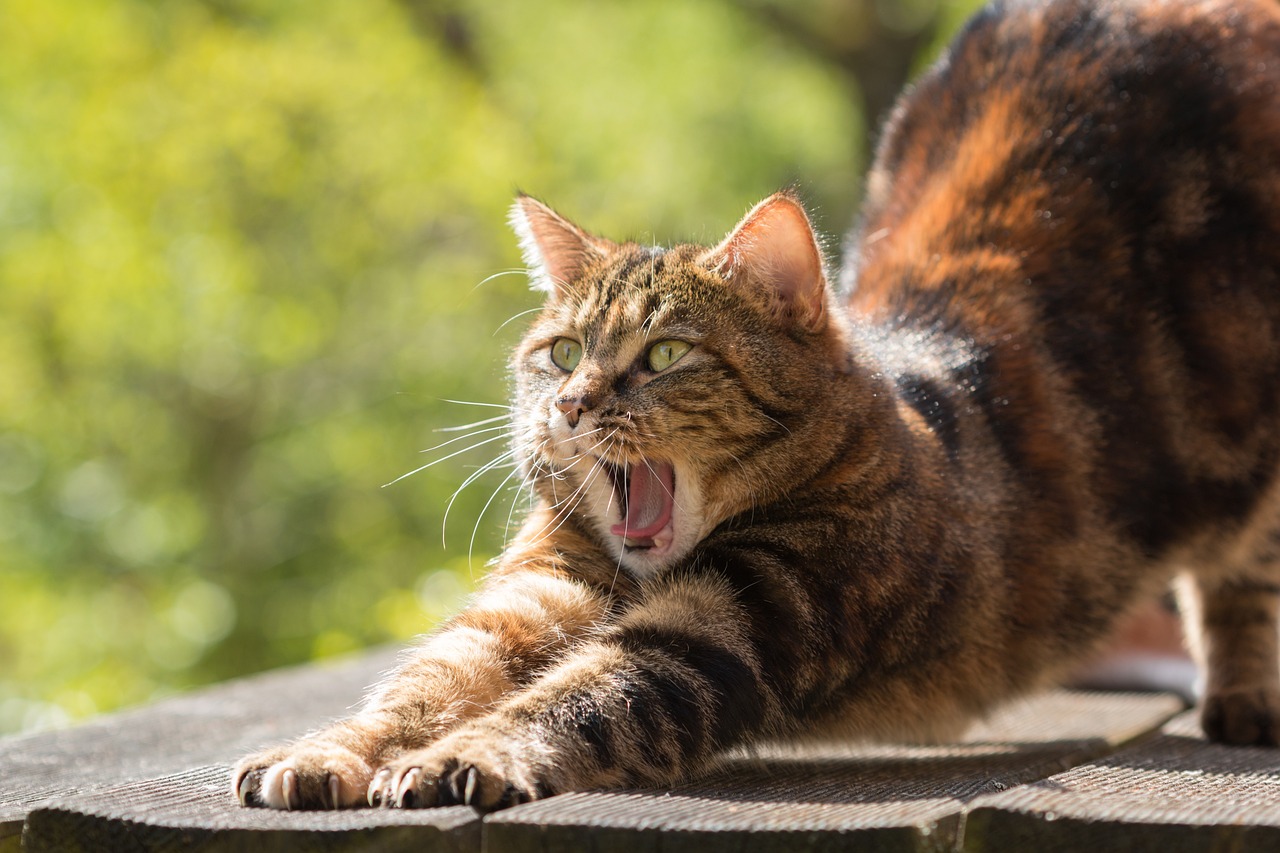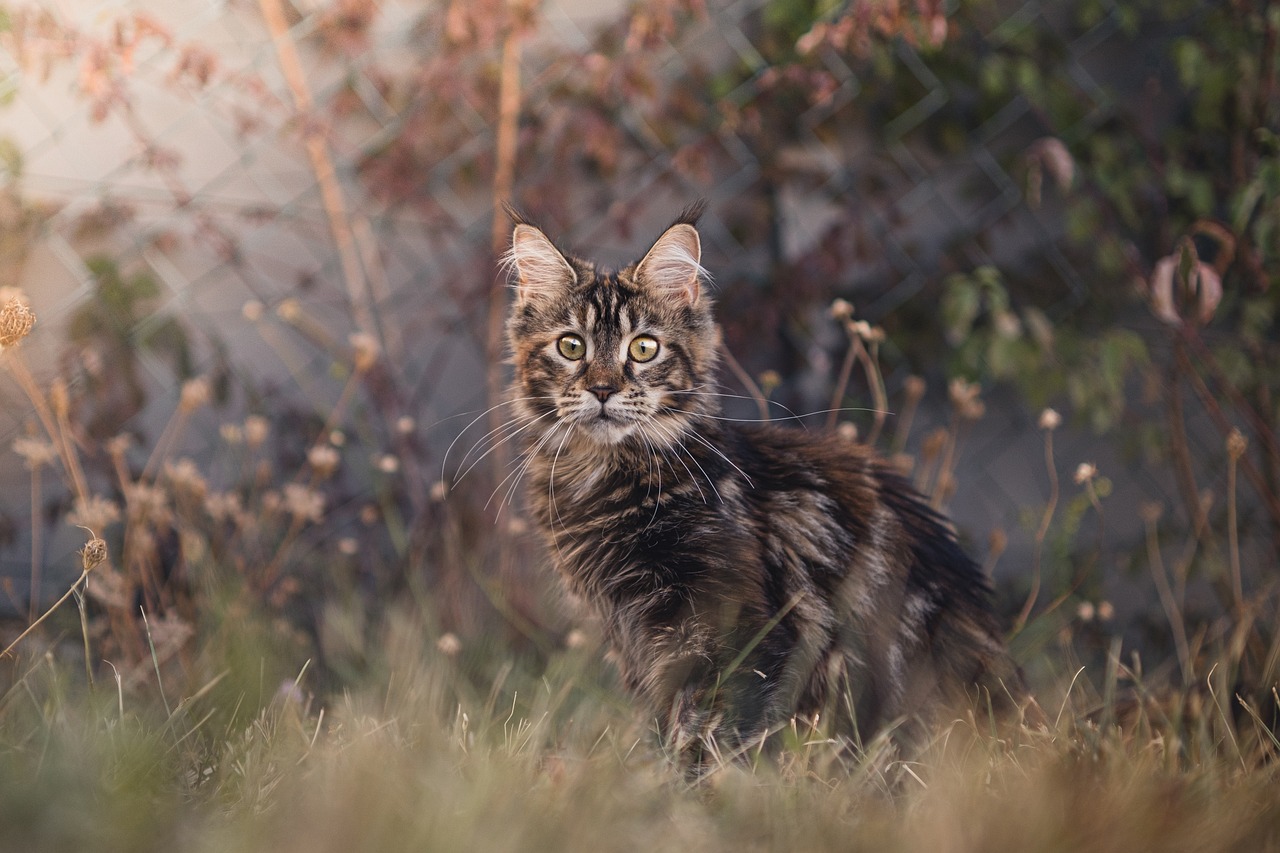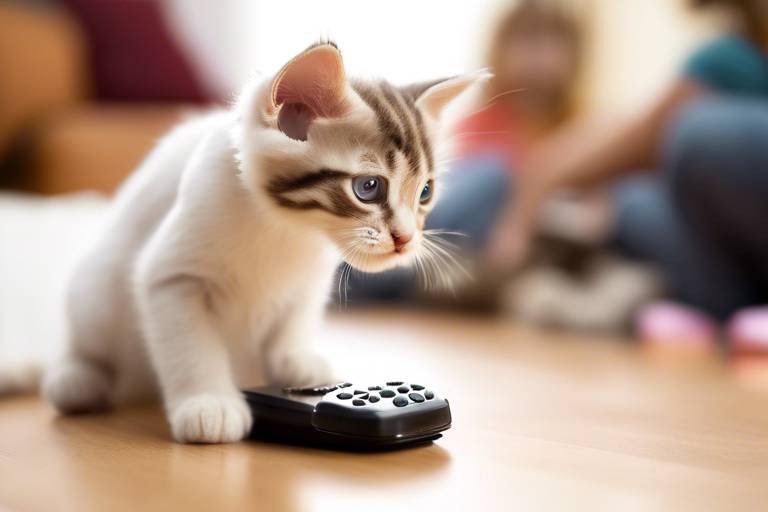The Benefits of Clicker Training for Cats
Clicker training for cats is more than just a trendy pet training method; it's a transformative approach that can enhance your feline friend's behavior, communication, and overall relationship with you. Imagine being able to teach your cat new tricks, curb unwanted behaviors, and even strengthen your bond—all through the simple sound of a clicker! This article explores the numerous advantages of clicker training for cats, including improved behavior, enhanced communication, and the strengthening of the bond between cats and their owners.
So, what exactly is clicker training? At its core, clicker training is a type of positive reinforcement that uses a distinct sound—a click—to mark desired behaviors. When your cat performs an action that you want to encourage, you click the device and then reward them with a treat. This method is effective because it helps your cat associate the sound of the click with positive outcomes. Think of it as a bridge between the behavior and the reward. It’s like saying, “Yes, that’s exactly what I wanted!” This clear communication helps your furry friend understand what you expect from them, making training sessions both enjoyable and productive.
One of the most significant benefits of clicker training is its ability to improve undesirable behaviors in cats. Whether your kitty is scratching the furniture, biting during play, or having issues with the litter box, consistent training can make a world of difference. By addressing these challenges through positive reinforcement, you can guide your cat towards more acceptable behaviors. For instance, if your cat is prone to scratching, you can click and reward them when they use a scratching post instead. Over time, this helps to redirect their instincts in a more appropriate manner.
Clicker training isn’t just about correcting bad habits; it's also about encouraging positive actions! By rewarding good behaviors, you can create a cycle of positivity. For example, you might want to reinforce behaviors like:
- Using the litter box correctly
- Playing gently with their toys
- Responding to their name
- Following basic commands like "sit" or "high five"
Each of these actions can be reinforced through clicker training, making it a powerful tool for shaping your cat's behavior in a positive way.
Believe it or not, clicker training can also help reduce anxiety in cats! Many cats thrive on routine and predictability, and training provides just that. When your cat knows what to expect during training sessions, it creates a more relaxed environment. This structure can help alleviate fears associated with new experiences, such as vet visits or changes in their surroundings. Instead of feeling anxious, your cat can focus on learning and bonding with you, making it a win-win situation.
Engaging in clicker training can significantly boost a cat's confidence. As your furry friend masters new skills and receives positive reinforcement, they become more self-assured. Imagine your once-timid cat confidently jumping through hoops or performing tricks. This newfound confidence can spill over into other areas of their life, making them more adventurous and curious about their surroundings.
Clicker training fosters better communication between you and your feline companion. By using a consistent sound to mark behaviors, your cat learns to understand your cues and commands more effectively. This enhanced communication can lead to a deeper understanding of each other, making your interactions more meaningful. Think of it as learning a new language together—one that strengthens your bond and makes life more enjoyable for both of you.
Clicker training is not just about teaching tricks; it's about creating a strong emotional connection between you and your cat. The time spent training together is valuable bonding time that can enhance your relationship. As you work together to achieve goals, you build trust and mutual respect. This emotional connection can lead to a more harmonious household, where both you and your cat feel understood and appreciated.
Let’s face it—training sessions can be a blast! By making clicker training fun and engaging, you can look forward to these interactions. Use colorful toys, tasty treats, and a playful attitude to keep your cat excited about learning. Remember, the more enjoyable the experience, the more likely your cat will want to participate. It’s like playtime with a purpose!
The advantages of clicker training extend well beyond immediate results. With consistent practice, you’ll find that your cat’s behavior improves over time, leading to a more peaceful and harmonious household. You'll also enjoy the long-term benefits of enhanced communication and a stronger bond with your pet. Just like any good relationship, the effort you put into training will pay off in dividends, resulting in a happier, more well-adjusted feline companion.
Q: How long does it take to see results with clicker training?
A: Results can vary, but many cat owners notice positive changes within a few weeks of consistent training.
Q: Can all cats be clicker trained?
A: Yes! Most cats can learn through clicker training, though some may require more patience than others.
Q: What if my cat doesn't respond to the clicker?
A: Ensure that you are using high-value treats and that your timing with the click is precise. You may need to experiment to find what motivates your cat.

Understanding Clicker Training
Clicker training is a remarkable and effective method for teaching your cat new behaviors and commands, all while enhancing your relationship with your feline friend. At its core, clicker training involves using a small handheld device that makes a distinct sound—often a "click"—to mark the exact moment your cat performs a desired behavior. This technique is based on the principles of positive reinforcement, where rewarding good behavior encourages your cat to repeat it in the future.
So, how does it work? When you click the device at the precise moment your cat does something you want, you follow it up with a reward, usually a treat or praise. This creates a clear association in your cat's mind: "Click means I did something right, and I get a reward!" Over time, your cat learns to associate the sound of the clicker with positive outcomes, making it more likely to repeat the behavior.
It's important to note that clicker training is not just about teaching tricks or commands; it's about building a deeper understanding between you and your cat. This method can be particularly useful for cats who may not respond well to traditional training methods. The sound of the clicker can capture their attention, making it easier to guide them through the learning process.
Here are some key components that make clicker training so effective:
- Timing: The click must happen at the exact moment the desired behavior occurs. This precision helps your cat understand what they are being rewarded for.
- Consistency: Always use the clicker in the same context and follow it with a reward. This builds a strong connection in your cat's mind.
- Patience: Training takes time, and every cat learns at their own pace. Being patient and persistent is crucial.
Clicker training can be used for a variety of behaviors, from simple commands like "sit" or "high five" to more complex tricks. Additionally, it can help address behavioral issues such as scratching or jumping on counters. By using this method, you're not just correcting unwanted behaviors; you're also teaching your cat what they can do instead.
In summary, clicker training is a fun and rewarding way to communicate with your cat. By using a simple sound to mark desired behaviors and following it up with a treat or praise, you can effectively teach your cat new tricks while strengthening the bond you share. The beauty of clicker training lies in its simplicity and effectiveness, making it an excellent choice for cat owners looking to improve their pet's behavior and overall happiness.

Improving Cat Behavior
Clicker training is not just a trendy method; it’s a transformative tool that can significantly improve your cat's behavior. Imagine a world where your feline friend no longer scratches the furniture or ignores the litter box. Sounds like a dream, right? Well, with clicker training, that dream can become a reality. This positive reinforcement technique allows you to communicate effectively with your cat, leading to a more harmonious living environment for both of you.
One of the most common issues cat owners face is undesirable behaviors. These can range from scratching furniture to aggressive biting. Instead of resorting to punishment, which can lead to fear and anxiety, clicker training focuses on rewarding good behavior. By consistently marking and rewarding the behaviors you want to see—like using the scratching post instead of the couch—you help your cat learn what is acceptable. This method is not only more humane but also more effective in the long run.
Let’s break down some specific behaviors that can be improved through clicker training:
- Scratching: Redirect your cat’s scratching habits by rewarding them for using a scratching post. Every time they choose the post over your furniture, click and treat!
- Litter Box Issues: If your cat is having accidents, you can encourage them to use the litter box by rewarding them when they go in the right place.
- Biting and Aggression: If your cat tends to bite during play, clicker training can help them learn to play gently. Reward them for soft paws!
By focusing on rewarding positive actions, you create a feedback loop that encourages your cat to repeat those good behaviors. This is much like teaching a child to share by praising them when they do. The more you reinforce the behavior you want, the more likely your cat will engage in it. It's all about creating an environment where your cat feels safe and appreciated.
Moreover, clicker training can also help in reducing anxiety and fear. Cats thrive on routine and predictability, and training sessions can provide just that. When your cat knows what to expect and feels rewarded for their efforts, they are less likely to exhibit anxiety-driven behaviors. This structured approach not only calms your cat but also builds a trusting relationship between you two.
As your cat begins to master new skills, you’ll notice a boost in their confidence. Each successful training session acts as a stepping stone, leading to a more self-assured feline. Think of it like teaching a kid to ride a bike; once they get it, their confidence soars, and they’re eager to take on new challenges. In the same way, your cat will become more adventurous and willing to explore new activities.
In conclusion, improving cat behavior through clicker training is a rewarding journey for both you and your pet. By focusing on positive reinforcement, you not only address undesirable behaviors but also promote a happier, more confident cat. So why not give it a try? You might be surprised at the transformation!
Encouraging Positive Actions
Clicker training is not just about correcting bad behavior; it's also a fantastic way to encourage positive actions in your feline friend. Imagine this: every time your cat does something you love, like using the scratching post instead of your couch, you can reward them with a click and a treat. This simple act creates a clear connection in your cat's mind between their actions and the rewards they receive. It's like a little light bulb going off, saying, "Hey, this is what I should be doing!"
One of the most exciting aspects of clicker training is that it allows you to shape your cat's behavior over time. You can start with basic commands like "sit" or "high five" and gradually move on to more complex tricks. Each successful attempt can be marked with a click, reinforcing their understanding and encouraging them to repeat those actions. In essence, you're building a language of sorts between you and your cat, where each click signifies a job well done.
To make the most of this training method, it's crucial to be consistent. Cats thrive on routine, and knowing what to expect can help them feel more secure. For instance, if you always click and treat when they perform a desired behavior, they'll quickly learn to associate that behavior with positive outcomes. Here are some specific positive actions you might want to encourage through clicker training:
- Using the litter box properly
- Playing gently with toys
- Responding to their name
- Coming when called
By focusing on these behaviors, you not only improve your cat's overall conduct but also foster a sense of accomplishment in them. It's like giving them a little pat on the back every time they get it right! And let's not forget, training sessions can be a wonderful bonding experience. When your cat sees you as a source of fun and rewards, their enthusiasm for learning will skyrocket.
Moreover, the beauty of clicker training is that it can be tailored to fit your cat's unique personality. Some cats may be more food-driven, while others might respond better to playtime or affection. This flexibility allows you to create a training regimen that works best for your furry companion, ensuring that they remain engaged and motivated. So, grab that clicker and get ready to transform your cat into a well-behaved superstar!
Reducing Anxiety and Fear
When it comes to our furry companions, anxiety and fear can be significant hurdles that affect their overall well-being. Just like humans, cats can experience stress, and this can manifest in various ways, such as hiding, aggression, or even destructive behavior. But here’s the good news: clicker training can be an effective tool in reducing these feelings and creating a more harmonious environment for both you and your feline friend.
Imagine your cat as a little ball of energy, full of potential but often overwhelmed by the world around them. Clicker training introduces a sense of structure and predictability, which can be incredibly comforting. By using a consistent sound—a clicker—to mark desired behaviors, you provide your cat with clear feedback. This clarity helps them understand what is expected, reducing the uncertainty that often leads to anxiety.
Incorporating clicker training into your cat's routine can help them face their fears head-on. For instance, if your cat is scared of loud noises or other pets, you can gradually expose them to these stimuli while using the clicker to reward calm behavior. This method not only teaches them to cope with their fears but also reinforces positive responses. Over time, your cat will learn that these previously frightening situations can be managed, leading to a more confident and relaxed demeanor.
Moreover, clicker training sessions can serve as a bonding experience, which is crucial for anxious cats. Spending quality time together helps build trust and strengthens your relationship. When your cat sees you as a source of comfort and guidance, it can significantly reduce their anxiety levels. The clicker becomes a tool of reassurance rather than a source of stress.
To illustrate how clicker training can help reduce anxiety, consider the following examples of common fears in cats:
| Common Fear | Clicker Training Approach |
|---|---|
| Loud Noises | Gradual exposure to sounds while rewarding calm behavior. |
| Strange Visitors | Introduce visitors slowly, rewarding your cat for staying calm. |
| Other Pets | Supervised interactions with rewards for positive behavior. |
In conclusion, clicker training is not just about teaching tricks; it’s about creating a safe space for your cat to thrive. By reducing anxiety and fear through structured training, you equip your cat with the tools they need to navigate their world confidently. So why not give it a try? Your cat will thank you for it!
- What is clicker training? Clicker training is a positive reinforcement method that uses a sound to mark desired behaviors, helping cats understand what is expected of them.
- Can clicker training help with my cat's anxiety? Yes! Clicker training provides structure and predictability, which can significantly reduce anxiety and fear in cats.
- How long does it take to see results from clicker training? Results can vary, but with consistent practice, many owners see improvements in their cat's behavior within a few weeks.
- Is clicker training suitable for all cats? Most cats can benefit from clicker training, though some may require a more gradual approach, especially if they are particularly fearful.
Building Confidence
Engaging in clicker training can be a game changer for your feline friend, particularly when it comes to boosting their confidence. Just like humans, cats thrive on a sense of achievement, and clicker training provides them with the perfect platform to experience that. Imagine your cat, once timid and hesitant, now strutting around with newfound self-assurance after mastering a trick or two. It’s a sight that can warm any pet owner’s heart!
When you use a clicker, you are not just signaling to your cat that they’ve done something right; you’re also reinforcing their understanding of what behaviors are desirable. This clarity helps cats feel more secure in their actions. For instance, when your cat successfully navigates a new obstacle or performs a trick on command, the clicker sound becomes a symbol of their success. The reward that follows—be it a tasty treat or a gentle pet—further cements this positive experience.
Another aspect of building confidence through clicker training is the structure it provides. Cats, by nature, can be creatures of habit. They often find comfort in routines, and the predictability of training sessions can help alleviate anxiety. When they know what to expect, they can engage more freely in the learning process. This structured environment allows cats to experiment with their capabilities without the fear of failure, leading to a more self-assured demeanor.
Moreover, clicker training can be particularly beneficial for shy or fearful cats. By starting with simple, achievable tasks, you can gradually increase the complexity as your cat becomes more comfortable. For example, you might begin with teaching them to touch your hand with their nose. Once they master that, you can move on to more challenging tasks, such as jumping through a hoop. Each small victory builds their confidence, creating a positive feedback loop that encourages them to tackle even greater challenges.
In summary, clicker training is not just about teaching tricks; it’s a powerful tool for fostering confidence in cats. By providing clear communication, structured learning, and positive reinforcement, you can help your cat blossom into a more confident and self-assured companion. Imagine the joy of watching your once-timid kitty transform into a bold explorer, ready to take on the world—or at least the living room!
- What is clicker training? Clicker training is a positive reinforcement method that uses a sound (the click) to mark desired behaviors, followed by a reward.
- Can all cats be clicker trained? Yes! Most cats can learn through clicker training, though some may require more patience than others.
- How long should training sessions be? Short sessions of 5-10 minutes are ideal to keep your cat engaged and prevent boredom.
- What types of behaviors can I teach my cat? You can teach a variety of behaviors, from basic commands like "sit" to fun tricks like "high five."
- Is clicker training suitable for older cats? Absolutely! Older cats can benefit from clicker training just as much as younger ones.
Enhancing Communication
When it comes to our feline friends, communication can often feel like a game of charades. You know your cat wants something, but deciphering their meows, purrs, and body language can be a challenge. This is where clicker training shines! By using a clicker, you provide a clear and consistent sound that signals to your cat that they’ve done something right. It’s like giving them a high-five for their good behavior!
Through clicker training, you can teach your cat to associate the sound of the clicker with positive reinforcement, such as treats or affection. This connection not only helps your cat understand what behaviors are desirable but also fosters a deeper understanding between you two. When your cat learns that a specific action leads to a click and a reward, they start to recognize the cues you give, enhancing your overall communication.
Imagine this: your cat is scratching the furniture, and instead of scolding them, you click the moment they use their scratching post. The click tells them, “Yes! That’s what I want you to do!” Over time, your cat learns to respond to your cues, making it easier for you to guide them toward the behaviors you want to encourage. This kind of training creates a dialogue, where your cat not only hears your commands but also learns to respond effectively.
Additionally, clicker training can help you understand your cat’s unique personality and preferences. Every cat is different, and through training, you can discover what motivates them. Some cats may be treat-driven, while others might prefer playtime or affection as a reward. This understanding leads to a more personalized training experience, allowing you to adapt your communication style to suit your cat's needs.
Incorporating clicker training into your daily routine can also make communication more engaging and fun. You can set up training sessions that feel less like chores and more like playtime. For instance, you could create a mini obstacle course in your living room and use the clicker to guide your cat through it. Not only does this build their skills, but it also encourages them to pay attention to your cues, making your interactions more meaningful.
So, the next time you’re working on training your cat, remember that it’s not just about teaching them tricks. It’s about enhancing the bond you share and improving your communication. With patience and consistency, you’ll find that clicker training opens up a whole new world of understanding between you and your furry companion.
- What is clicker training? Clicker training is a positive reinforcement method that uses a sound (the clicker) to mark desired behaviors in pets.
- Can all cats be clicker trained? Yes! Most cats can learn through clicker training, although some may take longer than others to respond.
- How long should training sessions last? Keep sessions short, ideally around 5-10 minutes, to maintain your cat's interest and focus.
- What rewards should I use? Use treats, toys, or affection as rewards—whatever motivates your cat the most!
- Is clicker training suitable for older cats? Absolutely! Clicker training can benefit cats of all ages, including seniors.

Strengthening the Human-Cat Bond
When it comes to our furry friends, the bond we share with them is incredibly important. Clicker training is not just about teaching your cat tricks; it’s a fantastic way to enhance the relationship between you and your feline companion. Think of it as a bridge that connects your hearts through understanding and mutual respect. By engaging in clicker training, you’re not just instructing your cat; you’re creating a shared experience that fosters trust and affection.
During training sessions, you and your cat are working together towards a common goal. This collaboration transforms the training process into a fun and rewarding activity. Imagine your cat finally mastering a new trick and looking up at you with those big, curious eyes, waiting for your praise. That moment of success not only boosts your cat’s confidence but also deepens your emotional connection. You both feel accomplished, and that shared joy can lead to a stronger bond.
Moreover, clicker training encourages positive interactions. Every time you click and reward your cat for a good behavior, you are reinforcing not just the behavior but also your relationship. This method of communication helps your cat understand that you are a source of good things. It’s like saying, “Hey, I appreciate you!” in a language your cat can understand. Over time, this consistent positive reinforcement builds a sense of security and trust, which are the cornerstones of any strong relationship.
Additionally, the time spent training can be a wonderful opportunity for you to observe your cat’s unique personality and preferences. You might discover that your cat loves to play fetch or is particularly motivated by treats. This understanding allows you to tailor your training sessions to suit your cat’s individual needs, making the experience even more enriching. It’s a two-way street where both of you learn and grow together.
In essence, clicker training is more than just a tool for behavior modification; it’s a pathway to a deeper, more meaningful relationship with your cat. By investing time in training, you are investing in a bond that will bring joy and fulfillment to your life. Just like any relationship, the more effort you put in, the more rewarding it becomes. So grab that clicker, and let the fun begin!
- How long should training sessions last? - Ideally, keep training sessions short, around 5 to 10 minutes, to maintain your cat's focus and enthusiasm.
- Can I use clicker training for older cats? - Absolutely! Clicker training can be beneficial for cats of all ages, helping them learn new behaviors and reinforcing existing ones.
- What if my cat doesn't respond to the clicker? - If your cat seems disinterested, try using higher-value treats or ensuring the training environment is free from distractions.
Creating a Fun Learning Environment
When it comes to clicker training your cat, creating a fun learning environment is essential for success. Imagine this: you’re not just training your cat; you’re embarking on a delightful journey together. The atmosphere you cultivate during training sessions can make all the difference. Rather than turning training into a chore, why not transform it into an exciting game? After all, cats are naturally playful creatures, and incorporating fun into the process will not only keep their interest piqued but also strengthen your bond.
One way to achieve this is by using treats and toys that your cat loves. Start by identifying their favorite snacks or playthings. These will serve as powerful motivators during your sessions. You might consider setting up a small “training station” with their favorite items nearby. This creates a positive association with the training environment. You could even use a colorful mat or blanket to designate the training area, making it feel special and unique.
Another effective approach is to keep the training sessions short and sweet. Cats have short attention spans, so aim for sessions that last around 5 to 10 minutes. This way, your furry friend will remain engaged without feeling overwhelmed. Think of it like a quick burst of fun rather than a lengthy lecture. You can schedule multiple short sessions throughout the day, allowing your cat to absorb new skills in bite-sized pieces.
Incorporating playtime into your training can also enhance the experience. For instance, you could combine clicker training with a game of chase or hide-and-seek. When your cat successfully performs a desired action, reward them with a treat and then engage them in a quick round of play. This not only reinforces the behavior but also makes the training feel less formal and more like a fun activity.
Lastly, don’t forget to celebrate small victories! Cats thrive on positive reinforcement, so be sure to shower them with praise and affection when they succeed. Use a cheerful tone and maybe even a little dance to show your excitement. This will encourage your cat to look forward to training sessions, knowing that they’ll receive lots of love and attention for their efforts.
In summary, creating a fun learning environment for clicker training involves using your cat’s favorite treats and toys, keeping sessions short, incorporating playtime, and celebrating successes. By making training a joyful experience, you’ll not only teach your cat new skills but also deepen your relationship. So grab that clicker, and let the fun begin!
- Q: How long should each training session last?
A: Aim for 5 to 10 minutes to keep your cat engaged and prevent them from becoming overwhelmed. - Q: What if my cat doesn’t respond to the clicker?
A: Ensure you’re using high-value treats and that your cat associates the clicker sound with positive outcomes. You may need to spend some time getting them used to the sound. - Q: Can I use clicker training for older cats?
A: Absolutely! Clicker training can be beneficial for cats of all ages, helping to reinforce positive behaviors and enhance communication.
Long-Term Benefits of Training
When it comes to clicker training, the benefits extend far beyond just immediate results. Imagine a world where your cat not only understands what you want but actively participates in a harmonious household. This is the magic of clicker training! As you consistently engage in this training method, you’ll find that your cat's behavior improves over time, leading to a more peaceful and enjoyable living environment.
One of the most significant long-term benefits is the reduction of undesirable behaviors. Over time, as your cat learns to associate the click sound with positive reinforcement, behaviors like scratching furniture or inappropriate biting can diminish. This not only makes your life easier but also enhances your cat's overall well-being. It's like planting a seed: with the right care and attention, it blossoms into a beautiful flower.
Moreover, clicker training fosters a sense of routine and stability for your feline friend. Cats are creatures of habit, and by establishing a training schedule, you provide them with a predictable environment. This predictability can significantly reduce anxiety and stress levels in your cat, making them feel more secure in their surroundings. A calm cat is a happy cat, after all!
As you continue to train your cat, you might notice a boost in their confidence. Each successful command or trick they master adds to their self-esteem, creating a more self-assured feline companion. Just like humans, cats thrive on success. When they realize they can accomplish tasks, they become more adventurous and curious, exploring their environment with newfound courage.
Additionally, the bond between you and your cat deepens over time as you engage in this training together. The shared experience of learning not only enhances communication but also creates lasting memories. Think of it as building a bridge; every click and treat strengthens that connection, allowing for a more profound understanding of each other.
In the long run, the time and effort you invest in clicker training lead to a more harmonious household. A well-trained cat is not only more enjoyable to be around, but they also contribute to a peaceful living space. You’ll find that your cat is less likely to engage in destructive behaviors, and you’ll spend less time worrying about potential mishaps. Instead, you can focus on enjoying the delightful quirks and antics that make your feline friend so special.
In summary, the long-term benefits of clicker training are numerous and impactful. From improved behavior and reduced anxiety to enhanced confidence and a stronger human-cat bond, the advantages are clear. So, why not embark on this rewarding journey with your cat? With patience, consistency, and a clicker in hand, you’re well on your way to creating a happier, healthier, and more fulfilling relationship with your furry companion.
- What is clicker training? - Clicker training is a positive reinforcement method that uses a sound to mark desired behaviors in pets.
- How long does it take to see results? - Results can vary, but many pet owners notice improvements within a few weeks of consistent training.
- Can any cat be clicker trained? - Yes! Most cats can be trained using this method, regardless of age or temperament.
- What types of behaviors can be trained? - Clicker training can be used for a variety of behaviors, including basic commands, tricks, and addressing undesirable habits.
Frequently Asked Questions
- What is clicker training and how does it work for cats?
Clicker training is a positive reinforcement method that uses a distinct sound, typically from a small handheld device, to mark desired behaviors in your cat. When your cat performs a behavior you want to encourage, you click the device and immediately reward them with a treat. This creates an association between the sound and the reward, helping your cat learn what behaviors are expected.
- Can clicker training help with bad behaviors?
Absolutely! Clicker training can be an effective way to address undesirable behaviors like scratching furniture, biting, or even litter box issues. By consistently rewarding good behavior, you can redirect your cat's actions and reinforce what they should be doing instead.
- How long does it take to see results from clicker training?
The time it takes to see results can vary widely depending on the cat and the behavior being addressed. Some cats may respond quickly, while others may take more time. With patience and consistency, you can start to notice improvements within a few sessions!
- Is clicker training suitable for all cats?
Yes, clicker training can be beneficial for cats of all ages and temperaments. Whether your cat is shy, anxious, or overly energetic, this method can help them learn and communicate better. Just be sure to tailor the training to your cat's individual needs!
- How can I make clicker training fun for my cat?
To keep things engaging, mix up the training sessions with different tricks and behaviors to learn. Keep sessions short and upbeat, and always end on a positive note. Using high-value treats that your cat loves can also make the experience more enjoyable for them!
- Will clicker training strengthen my bond with my cat?
Definitely! Training together creates a shared experience that can enhance your relationship. As you spend quality time teaching and rewarding your cat, you'll build trust and understanding, making your bond even stronger.
- What are the long-term benefits of clicker training?
The long-term benefits of clicker training include improved behavior, better communication, and a more harmonious household. Over time, the skills your cat learns can lead to a more confident and well-adjusted pet, reducing stress for both of you!



















